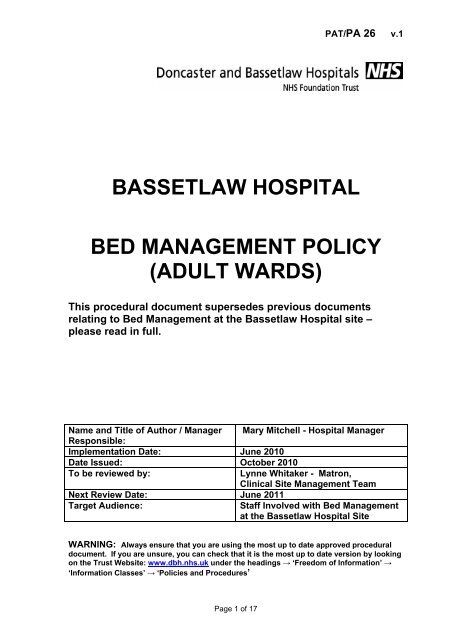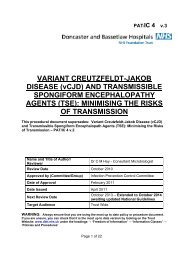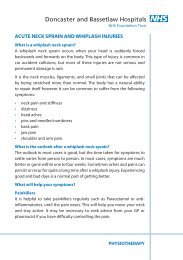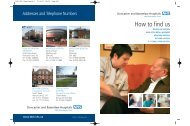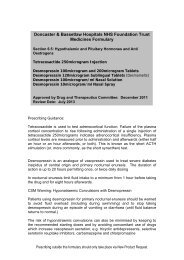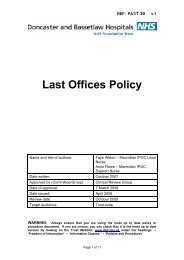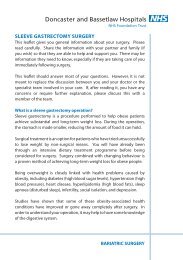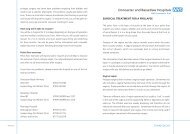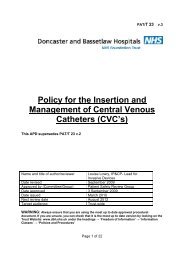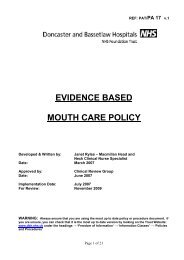bassetlaw hospital bed management policy - Doncaster and ...
bassetlaw hospital bed management policy - Doncaster and ...
bassetlaw hospital bed management policy - Doncaster and ...
Create successful ePaper yourself
Turn your PDF publications into a flip-book with our unique Google optimized e-Paper software.
BASSETLAW HOSPITAL<br />
Page 1 of 17<br />
PAT/PA 26 v.1<br />
BED MANAGEMENT POLICY<br />
(ADULT WARDS)<br />
This procedural document supersedes previous documents<br />
relating to Bed Management at the Bassetlaw Hospital site –<br />
please read in full.<br />
Name <strong>and</strong> Title of Author / Manager<br />
Responsible:<br />
Mary Mitchell - Hospital Manager<br />
Implementation Date: June 2010<br />
Date Issued: October 2010<br />
To be reviewed by: Lynne Whitaker - Matron,<br />
Clinical Site Management Team<br />
Next Review Date: June 2011<br />
Target Audience: Staff Involved with Bed Management<br />
at the Bassetlaw Hospital Site<br />
WARNING: Always ensure that you are using the most up to date approved procedural<br />
document. If you are unsure, you can check that it is the most up to date version by looking<br />
on the Trust Website: www.dbh.nhs.uk under the headings → ‘Freedom of Information’ →<br />
‘Information Classes’ → ‘Policies <strong>and</strong> Procedures’
Section<br />
1 Introduction<br />
BASSETLAW HOSPITAL<br />
BED MANAGEMENT POLICY<br />
CONTENTS<br />
2 Principles of the Policy<br />
3 Management Responsibility<br />
4 Bed Management<br />
5 Infection Prevention <strong>and</strong> Control<br />
6 Managing Bed Pressures<br />
Appendix A Intranet Information re Bed Status<br />
Appendix B Bed Manager E-Mail to External Personnel<br />
Appendix C Patient Transfer Guidance<br />
Appendix D Hospital Discharge Lounge<br />
Page 2 of 17<br />
PAT/PA 26 v.1<br />
Page<br />
No.<br />
3<br />
3<br />
3<br />
4<br />
8<br />
9<br />
11<br />
12<br />
14<br />
17
BASSETLAW HOSPITAL<br />
Page 3 of 17<br />
PAT/PA 26 v.1<br />
BED MANAGEMENT POLICY – ADULT ACUTE WARDS<br />
1. INTRODUCTION<br />
This <strong>policy</strong> clarifies action to be taken at Bassetlaw Hospital, as <strong>bed</strong> occupancy<br />
nears or exceeds full capacity. It describes the internal escalation principles to be<br />
considered by the Ward teams <strong>and</strong> Clinical Site Management teams (CSM) <strong>and</strong><br />
the communication cascade to Managers <strong>and</strong> Clinicians, as well as to other<br />
organisations.<br />
2. PRINCIPLES OF THE POLICY<br />
This <strong>policy</strong> defines:<br />
2.1 the circumstances for transferring existing in-patients within the <strong>hospital</strong> to<br />
create <strong>bed</strong>s in appropriate locations for anticipated new admissions<br />
2.2 the requirement of the clinical teams to undertake additional review of those<br />
patients who may be deemed fit for discharge, in order to create additional<br />
<strong>bed</strong> availability<br />
2.3 the use <strong>and</strong> function of the designated discharge lounge in order to create<br />
additional <strong>bed</strong> availability<br />
2.4 the communication within the <strong>hospital</strong> to alert teams with regard to the <strong>bed</strong><br />
status, which may inform the decision to cancel non-urgent elective<br />
admissions<br />
2.5 the communication necessary with other organisations e.g. the PCT <strong>and</strong> the<br />
Ambulance Services<br />
2.6 the communication with the Manager on Call teams<br />
3. MANAGEMENT RESPONSIBILITY<br />
3.1 All adult <strong>bed</strong>s within the Trust will be managed corporately under the<br />
direction of the Executive Team. The overall specialty <strong>bed</strong> allocation will be<br />
reviewed annually.<br />
3.2 The ‘<strong>bed</strong> holding’ <strong>management</strong> teams are responsible for ensuring the<br />
efficient use of <strong>bed</strong>s. This includes creating the capacity required to meet all<br />
elective <strong>and</strong> non-elective admissions <strong>and</strong> ensuring that all patients are<br />
regularly reviewed for discharge. The CSM is responsible for overviewing<br />
the appropriate use of the adult <strong>bed</strong>s on site.
Page 4 of 17<br />
PAT/PA 26 v.1<br />
3.3 The Bassetlaw Hospital Manager supports the ‘<strong>bed</strong> holding’ <strong>management</strong><br />
teams <strong>and</strong> the CSMs by reviewing <strong>bed</strong> availability on a regular basis, <strong>and</strong><br />
agreeing any escalation plan.<br />
3.4 The Out of Hours Manager may be contacted by the on-site CSM, for<br />
advice in relation to <strong>bed</strong> <strong>management</strong> <strong>and</strong> to authorise any escalation plan.<br />
He/she may have to liaise with the Executive Director on call if there is any<br />
request to/from other Trusts to help with pressure of <strong>bed</strong>s.<br />
4. BED MANAGEMENT<br />
4.1 Ward Updates<br />
Information will be published on the Intranet that will advise of the <strong>bed</strong> situation<br />
(see appendix A). Up to date information regarding the <strong>bed</strong> status across the<br />
<strong>hospital</strong> will be updated on the Intranet three times a day. The Intranet<br />
information will display the overall <strong>bed</strong> alert status for the <strong>hospital</strong> <strong>and</strong> by<br />
individual ward, ie<br />
• The number of <strong>bed</strong>s available<br />
• The anticipated discharges later that same day<br />
• The planned admissions i.e. elective cases, that day <strong>and</strong> the following day.<br />
• The number of patients waiting in the A & E Department awaiting admission<br />
to identified wards, with an indication of the time that they have been in that<br />
department.<br />
• The number of patients who may be waiting for transfer from the Critical<br />
Care Department to an in-patient ward<br />
The Intranet will be updated by the CSM at the following times of the day:<br />
07.00 a.m.<br />
11.30 a.m.<br />
4.30 p.m.<br />
8.00 p.m.<br />
4.2 The Role of Ward Managers/Shift Leads<br />
Ward Managers/Shift Leads are required to work corporately to ensure that<br />
there are sufficient empty <strong>bed</strong>s on the wards to receive transfers from the<br />
Medical Assessment Unit, whilst also retaining the capability for an emergency<br />
admission to the surgical floor. The Ward Managers/Shift Leads on<br />
assessment areas should be proactive in ensuring that if there are empty <strong>bed</strong>s<br />
across the <strong>hospital</strong>, they should plan patient movement to ensure that there is<br />
minimal delay in transfers. Other Ward Managers/Shift Leads should be<br />
anticipating a request to receive patient transfers into their empty <strong>bed</strong>s.<br />
In extreme circumstances, it may be necessary to ‘sleep out’ a patient to an<br />
alternative specialist ward, in order to facilitate emergency admissions. Ward<br />
Managers/Shift Leads when assessing which patients might be identified for
Page 5 of 17<br />
PAT/PA 26 v.1<br />
transfer, must follow the ‘Patient Transfer’ guidance – see Appendix C. Ward<br />
Managers/Shift Leads are expected to work together to activate transfers as<br />
quickly as possible, this may involve the receiving ward agreeing to retrieve the<br />
transfer.<br />
The system will advise Surgical Ward Managers/Shift Leads of the planned<br />
elective admissions to their wards, which will also inform their ability to receive<br />
transferred patients.<br />
When the CSM visits the wards routinely, he/she will expect the Ward<br />
Managers/Shift Leads to have already considered what action, if any, needs to<br />
be taken to relocate the empty <strong>bed</strong>s. Ward Managers/Shift Leads should not<br />
wait for the CSM to identify that action is required. They will also be able to<br />
advise the CSM of anticipated discharges, if the information is different from<br />
that displayed on the Intranet.<br />
Ward Managers/Shift Leads must ensure that all patients ready for discharge<br />
are moved to the Discharge Lounge as soon as possible – see Appendix D re<br />
the Discharge Lounge. The movement of such patients in a timely way, can<br />
avoid another patient having to be transferred unnecessarily. Or a patient<br />
waiting in the A & E Department for admission.<br />
Representatives from the medical <strong>and</strong> surgical wards as well as the A & E<br />
Department are required to attend regular update meetings called by the<br />
CSM/Hospital Manager.<br />
WARD MANAGER/SHIFT LEAD<br />
BED MANAGEMENT – ACTION<br />
i. At the commencement of the shift, check the Intranet system to<br />
determine the <strong>bed</strong> situation across the <strong>hospital</strong>.<br />
ii. Check if there are any anticipated transfers from the assessment<br />
areas to your ward.<br />
iii. If there are empty <strong>bed</strong>s in the <strong>hospital</strong> but not on the appropriate<br />
wards to receive new admissions/transfers, identify any potential<br />
patient movement – see Appendix C re patient transfers.<br />
.<br />
The CSM will require this information.<br />
iv. Identify patients ready for discharge <strong>and</strong> make immediate<br />
arrangements for transfer to the Discharge Lounge – see Appendix<br />
D re the Discharge Lounge.<br />
The CSM will require this information.
4.3 The Role of the Waiting List Office<br />
Page 6 of 17<br />
PAT/PA 26 v.1<br />
The Waiting List Office will update the Intranet information about planned<br />
elective admissions to each ward. They should indicate the status of the<br />
patient’s admission e.g.<br />
• Clinically urgent<br />
• Cancer<br />
• Previously cancelled<br />
• ‘Breach’ status<br />
This information is crucial in case it is necessary to cancel any admission due<br />
to the shortage of <strong>bed</strong>s.<br />
4.4 Patient Transfer Guidance - See Appendix C<br />
4.5 Hospital Discharge Lounge - See Appendix D<br />
4.6 Guidelines for the Repatriation of Patients from other <strong>hospital</strong>s<br />
see Appendix E<br />
4.7 The Role of the Clinical Site Management (CSM) Team<br />
This Manager will update the Intranet (see Appendix A) which will give up to<br />
date information regarding the <strong>bed</strong> status across the <strong>hospital</strong>. The content <strong>and</strong><br />
frequency of the information is detailed below in the CSM – Action Card.<br />
All staff has access to the <strong>bed</strong> status information via the Intranet. The CSM, as<br />
he/she visits the wards, should expect Ward Managers/ Shift leads to have<br />
given consideration to possible patient transfers, to ensure that there are<br />
sufficient <strong>bed</strong>s available to receive transfers/emergency admissions, planned<br />
admissions <strong>and</strong> transfers from the A & E Department.<br />
The CSM member will need to liaise with the A & E Department, to gauge the<br />
potential dem<strong>and</strong> for <strong>hospital</strong> admission from that department <strong>and</strong> therefore<br />
<strong>bed</strong>s, before agreeing to the proposed patient transfers.<br />
This Manager is expected to leave messages at h<strong>and</strong>over indicating the current<br />
<strong>bed</strong> status within the <strong>hospital</strong> <strong>and</strong> any action plan designed to address any<br />
problems, this includes advising the on-call senior manager of the situation.<br />
For guidance in managing <strong>bed</strong> pressures, see section 6
CLINICAL SITE MANAGERS<br />
BED MANAGEMENT – ACTION<br />
Page 7 of 17<br />
PAT/PA 26 v.1<br />
i. Update the Intranet information four times each day, to include:<br />
• The overall <strong>bed</strong> alert status for the <strong>hospital</strong><br />
• The number of <strong>bed</strong>s occupied<br />
• The number of <strong>bed</strong>s available<br />
• The anticipated discharges later that same day<br />
• The planned admissions i.e. elective cases, that day <strong>and</strong> the following day.<br />
• The number of patients waiting in the A & E Department awaiting admission to<br />
identified wards, with an indication of the time that they have been in that<br />
department.<br />
• The number of patients in the Critical Care department awaiting transfer to an inpatient<br />
ward<br />
The Intranet information will be created by the Clinical Site Manager, at the following<br />
times of the day:<br />
7.00 a.m.<br />
11.30 a.m.<br />
4.30 p.m.<br />
8.00 p.m.<br />
ii. If patient transfers are required, to ensure that the available <strong>bed</strong>s are<br />
in the appropriate areas, liaise with the Ward Managers/Shift Leads to ascertain<br />
their proposals for patient transfers.<br />
iii. Movement <strong>and</strong> placement of patients with suspected or proven infection should be<br />
jointly agreed with the CSM <strong>and</strong> a member of the infection prevention <strong>and</strong><br />
control team.<br />
iv. If patient discharges are identified liaise with the Ward Managers/Shift Leads to<br />
ensure that these patients are transferred to the Discharge Lounge as soon as<br />
possible.<br />
v. If the <strong>bed</strong> status of the <strong>hospital</strong> changes advise the personnel<br />
identified in Bed Management Policy (para 6.3) Ensure that information, on action<br />
taken or proposed, is communicated at h<strong>and</strong>over. This includes informing the on-<br />
call senior manager.<br />
vi. If when on amber alert there is an indication that the situation is<br />
likely to deteriorate, request the medical teams to undertake further patient<br />
reviews to identify additional discharges.<br />
vii If on amber/red alert, consider in liaison with the Surgical Manager <strong>and</strong>/or the<br />
Hospital Manager the cancellation of elective admissions the following day. Advise<br />
the Waiting List Office Manager <strong>and</strong> Theatre Manager of any proposed<br />
cancellations.<br />
viii Be the single point of contact, for the Community Nursing Teams, with regard to<br />
reviewing patient’s potential for discharge.
4.8 The Role of Medical Secretaries<br />
Page 8 of 17<br />
PAT/PA 26 v.1<br />
The Medical Secretaries of the <strong>bed</strong>-holding Consultants are expected to review<br />
the Intranet information regarding the <strong>hospital</strong>’s <strong>bed</strong> status. They are expected<br />
to advise their Consultants when the <strong>hospital</strong> has less than 4 available <strong>bed</strong>s, so<br />
that their Consultants can undertake further patient reviews for discharge <strong>and</strong><br />
also appreciate that there may need to be some cancellation of planned<br />
surgical admissions.<br />
When the <strong>hospital</strong> is on Amber or Red status, Medical Secretaries should not<br />
call for late elective admissions the following day, without reference to the<br />
Clinical Site Manager, as it may be necessary to st<strong>and</strong>-down a particular<br />
theatre list, due to the shortage of <strong>bed</strong>s.<br />
4.9 The Role of Matrons on site<br />
Matrons can overview the situation, by accessing the Intranet <strong>and</strong> ensuring that<br />
the Ward Managers/Shift Leads are being proactive in anticipating patient<br />
transfers/discharges.<br />
5. INFECTION PREVENTION AND CONTROL<br />
When there are competing dem<strong>and</strong>s for <strong>bed</strong>s/single rooms, Clinical Site Managers<br />
<strong>and</strong> the infection Prevention <strong>and</strong> Control Team should jointly agree on the<br />
placement of patients with suspected or proven infection.<br />
The correct <strong>and</strong> timely placement of these patients into a single room can be very<br />
effective in reducing the overall risk of colonisation in other patients within the<br />
ward.<br />
When there are significant numbers of patients infected or colonised with the same<br />
organism, isolation practices can be carried out within the ward area; this is called<br />
cohorting. This is generally used when the number of cases exceeds single room<br />
capacity. The Trust Isolation Policy PAT/IC gives clear guidelines on how staff<br />
should prioritise the need for isolation facilities.<br />
5.1 Movement of Patients<br />
Transfer <strong>and</strong> movement of patients with suspected or proven infection should<br />
be kept to a minimum <strong>and</strong> should only be undertaken for clinical reasons.<br />
If a transfer is necessary, the receiving area must be informed so that<br />
effective infection control measures can be put into place.<br />
H<strong>and</strong> hygiene <strong>and</strong> personal protective equipment procedures should be<br />
closely followed when transferring an infected patient
Any equipment used to transfer the patient, eg trolley, must be<br />
decontaminated appropriately (refer to PAT/IC policies)<br />
6. MANAGING BED PRESSURES<br />
Page 9 of 17<br />
PAT/PA 26 v.1<br />
6.1 The Role of the Clinical Site Management Team (see section 4.7 also)<br />
The CSM will lead a daily review of the <strong>bed</strong> situation to agree action to be<br />
taken. This forum will include a combination of the following managers based<br />
at Bassetlaw Hospital:<br />
• Clinical Site Manager<br />
• Hospital Manager<br />
• Matron/nursing representative, Medical Wards<br />
• Matron/nursing representative, Surgical Wards<br />
• Lead nurse/representative, A & E Department<br />
In the event of the Hospital Manager not being on site, contact can be made via<br />
mobile or the secretary on Ext 2772.<br />
Although the information in respect of future elective admissions will be on the<br />
Intranet system, further input to this forum may be required from the<br />
• Waiting List Office Manager<br />
• Theatre Manager<br />
These Managers should be advised immediately, if any decision is reached to<br />
cancel elective admissions.<br />
The decision taken by this forum, should be communicated to the on-coming<br />
CSM. Such communications should be left in the Manager’s folder, which is<br />
h<strong>and</strong>ed over as new Managers take up their shift.<br />
The CSM must inform the Clinical Site Management team at DRI either by<br />
phone call/Email of any changes in the alert status. The Hospital Manager must<br />
also be advised by Email, if the status is changed out of hours.<br />
6.2 Bed Alert Status<br />
There are 3 stages in the Bed Alert status, i.e.<br />
GREEN – There are available <strong>bed</strong>s <strong>and</strong> no anticipated disruption to service<br />
Delivery<br />
AMBER – There are only 4 available <strong>bed</strong>s PLUS non-urgent elective cases are<br />
being cancelled.<br />
RED - There are no available <strong>bed</strong>s PLUS urgent elective cases are being<br />
cancelled
6.3 Escalation/de-escalation of Amber <strong>and</strong> Red status<br />
Page 10 of 17<br />
PAT/PA 26 v.1<br />
Before any action is taken by the CSM to escalate the Bed Status in the<br />
<strong>hospital</strong> to either AMBER or RED, medical teams must be requested to review<br />
patients for discharge. It may be possible to avoid escalation if further<br />
discharges are identified.<br />
In the event of the status being changed, the CSM member must communicate<br />
this information by updating the Intranet information. They must also telephone<br />
the local PCT Single Point of Access (in–hours) or via Derbyshire Healthcare<br />
(out-of-hours) <strong>and</strong> Ambulance Services (see below <strong>and</strong> Appendix B). It will<br />
however still be necessary to telephone other local <strong>hospital</strong>s, in order to<br />
ascertain their <strong>bed</strong> availability. This information should be passed to the on-call<br />
medical teams, so that they may in turn advise GPs anxious to admit a patient.<br />
When the <strong>hospital</strong> escalates to RED, the Bassetlaw PCT requires additional<br />
information as to what action is being taken to address the problem (see<br />
Appendix B)<br />
Local Hospital telephone numbers:<br />
Short dial Telephone Number<br />
Chesterfield 87 304 01246 277271<br />
Royal Hallamshire 87-335 0114 2711900<br />
Northern General 87-322 01623 622515<br />
Rotherham 87-340 0114 2434343<br />
Kings Mill 87-313 01709 820000.<br />
AMBULANCE SERVICES<br />
EMAS YAS<br />
In-hours-Telephone - Performance Delivery Manager Team Leader<br />
E Mail Team Leaders – see CSM file<br />
Out of hours Ambulance Control Ambulance Control
Intranet Information<br />
from: Bed Manager / Nurse Practitioner / Bleep holder<br />
re: Bassetlaw Hospital Bed Status: RED / AMBER / GREEN<br />
on ………………….. (date) at ………………….. (time)<br />
Ward Empty<br />
Beds<br />
MSS<br />
CCU<br />
C1<br />
C2<br />
B7<br />
A4<br />
A5<br />
B5<br />
B6<br />
B7<br />
TOTAL<br />
* Status<br />
1 Clinically urgent<br />
2 CANCER<br />
Anticipated<br />
Discharges<br />
3 Previously cancelled<br />
4 Breach status<br />
Outst<strong>and</strong>ing Planned<br />
Admissions<br />
Today Tomorrow Today Tomorrow Status<br />
*<br />
Page 11 of 17<br />
PAT/PA 26 v.1<br />
APPENDIX A<br />
Awaiting A & E<br />
Transfer Aw\aiting<br />
From ITU Admission<br />
No No To be admitted<br />
by (time)
Page 12 of 17<br />
PAT/PA 26 v.1<br />
APPENDIX B<br />
Information to be communicated to “external” personnel listed in para 6.3<br />
From Clinical Site Manager<br />
Re: Bassetlaw Hospital Bed Status<br />
Date: …………………………..<br />
At …………………. Insert time) this <strong>hospital</strong> went onto<br />
GREEN There are available <strong>bed</strong>s <strong>and</strong> no anticipated<br />
disruption to service delivery.<br />
AMBER There are only 4 available <strong>bed</strong>s PLUS nonurgent<br />
elective cases are being cancelled.<br />
RED* There are no <strong>bed</strong>s available PLUS urgent<br />
elective cases are being cancelled.<br />
NB<br />
Please tick <br />
i When on red status, the A & E Department will still receive <strong>and</strong><br />
stabilise patients for transfer, as the <strong>hospital</strong> has NO <strong>bed</strong>s. However, it<br />
is hoped that the Ambulance Service <strong>and</strong> GPs will divert admissions if<br />
possible.<br />
ii If the <strong>hospital</strong> moves to RED ALERT, the PCT requires additional<br />
information. The attached pro forma should be completed <strong>and</strong> sent<br />
with this e-mail.
Page 13 of 17<br />
PAT/PA 26 v.1<br />
Bassetlaw Hospital is currently on Red Alert. This means that there are 0 adult<br />
<strong>bed</strong>s available, with no potential discharges or other options to identify unoccupied<br />
<strong>bed</strong>s.<br />
Please note that this may have an impact on the clinical work of the PCT, as the<br />
<strong>hospital</strong> are advising that only emergency admissions are to be referred. Please<br />
ensure that your staff is aware of the situation, <strong>and</strong> where necessary please also<br />
ensure that you liaise closely with staff in general practice.<br />
We will notify you as soon as the situation changes.<br />
Please insert here the reason behind the <strong>bed</strong> alert<br />
How long will this cause a problem?<br />
What is the Trust doing about the issue?<br />
Single Point of Access<br />
Retford Hospital<br />
Tel: 01777 274422<br />
RED ALERT
PATIENT TRANSFER GUIDANCE<br />
1. Introduction<br />
Page 14 of 17<br />
PAT/PA 26 v.1<br />
APPENDIX C<br />
Ideally all patients should receive their on-going treatment in the appropriate specialist<br />
ward. However occasionally, due to the pressure of admissions in a particular specialty, it<br />
is necessary to ‘sleep-out’ patients to a ward within another specialty. Such transfers<br />
should be anticipated by the Ward Managers <strong>and</strong> appropriate arrangements made for a<br />
satisfactory transfer.<br />
This guidance should be used in order to ensure that empty <strong>bed</strong>s within the <strong>hospital</strong> are<br />
located on the admission areas.<br />
Whilst every effort should be taken to minimise disruption to patients through transfer, this<br />
is often a necessary course of action. Patients, <strong>and</strong> their relatives / carers, should<br />
therefore be advised <strong>and</strong> prepared for the possibility of transfer.<br />
2. Patient Selection<br />
The following patients may be considered as the most suitable to be transferred:<br />
1. A patient with an established plan of care, who can be safely managed in a nonspecialised<br />
area.<br />
2. A patient who has a discharge plan / date who will be subsequently discharged either<br />
home or to a Residential / Nursing Home.<br />
3. In circumstances where the patients identified in (1) or (2) are unavailable, wards must<br />
identify the most medically stable patient for transfer.<br />
3. Patients unsuitable for transfer<br />
The following patients are unsuitable for transfer:<br />
• Patients with known or suspected infection which poses a risk of cross-infection,<br />
including MRSA, C-difficile <strong>and</strong> Diarrhoea <strong>and</strong> Vomiting (D&V).<br />
• Patients with a confirmed or suspected communicable infection e.g. open<br />
tuberculosis, chickenpox, measles, etc., unless after discussion with IPC team.<br />
• Patients identified as acutely confused.<br />
• Patients considered medically unstable.<br />
• Patients with an imminent death. It is likely that these patients will be on the Care<br />
of the Dying Integrated Pathway of Care.<br />
• Patients identified as immunosupressed<br />
• Patients who have already undergone a previous ward transfer.
4. Transfer Process<br />
Page 15 of 17<br />
PAT/PA 26 v.1<br />
Ward Managers must refer to the <strong>bed</strong> status information E-mailed to all the wards <strong>and</strong><br />
anticipate that there will be a request for some patient transfers to ensure that there are<br />
<strong>bed</strong>s available on the admission areas. They should therefore begin to identify which<br />
patients are suitable for transfer <strong>and</strong> consider what action must be taken to respond to a<br />
request for patients to be transferred.<br />
The Clinical Site Manager will expect that the Ward Managers have anticipated the<br />
request for patient transfers <strong>and</strong> so, when visiting the wards, will be advised of which<br />
patients are suitable for transfer. He/she will then be able to confirm which patients are to<br />
be moved <strong>and</strong> to which location. He/she should also indicate the speed in which the<br />
transfer must be completed, possibly because of pressures from General Practitioners<br />
<strong>and</strong>/or the A & E Department to expedite the emergency admissions.<br />
The Ward Manager must inform the patient that they have been selected for transfer to<br />
another ward. It is important that this information is conveyed sensitively, with a detailed<br />
rationale for why this action is required. Staff should be proactive in delivering the<br />
message to the patient to ensure compliance.<br />
The Ward Manager must then ensure that<br />
• the st<strong>and</strong>ard Transfer Documentation is completed (see annex 1) <strong>and</strong> the receiving<br />
ward is made aware of the transfer.<br />
• the patients’ personal belongings are prepared for transfer, along with named<br />
medication <strong>and</strong> all relevant records.<br />
• in the event of a medical patient being transferred to a surgical ward, the printed<br />
copy of the Electronic Medication Administration Chart (MAC Report) is attached to<br />
the Patients’ notes.<br />
• once transfer arrangements are in place, the patients’ next of kin is advised of the<br />
transfer <strong>and</strong> the rationale given behind the transfer. In the event of the next of kin<br />
being unavailable, it should be the responsibility of the Receiving Ward to ensure<br />
that this communication occurs at the earliest possible opportunity.<br />
• the patient is transferred by the most appropriate member of staff, based on the<br />
assessment of clinical need. Contact Portering Staff, if necessary, to assist with the<br />
transfer of patient.<br />
It is important that patient privacy <strong>and</strong> dignity is maintained at all times.<br />
5. Receiving Ward<br />
When the Ward Managers reviews the <strong>bed</strong> status information E-mailed throughout the<br />
<strong>hospital</strong>, they must not only consider the potential for them to transfer patients out of their<br />
ward, but also to anticipate that they might be a receiving ward. They should therefore<br />
anticipate a request from the Clinical Site Manager to make arrangements to receive a<br />
patient being transferred from another ward. They should therefore:<br />
• receive patient specific details<br />
• begin preparation of appropriate <strong>bed</strong> area, including any equipment required.<br />
• communicate the expected transfer to the Ward Team. Nurse in Charge to<br />
nominate a member of staff to receive <strong>and</strong> welcome the patient.<br />
• nominated staff member to welcome patient <strong>and</strong> undertake initial baseline<br />
observations <strong>and</strong> establish any immediate care needs.<br />
• ensure that next of kin has been notified <strong>and</strong> patient is aware of this.
Patient Label<br />
Notes Yes No Buff<br />
Obs Forms Yes No<br />
Drug chart Yes No OTHER<br />
transferred.<br />
Named drugs Yes No<br />
Request forms Yes No<br />
Ward<br />
informed.<br />
Yes No<br />
Admissions<br />
aware<br />
Yes No<br />
Name b<strong>and</strong> Yes No<br />
Patient Yes No<br />
property.<br />
Family aware Yes No<br />
MRSA Positive Negative Screened<br />
Referrals<br />
Yes<br />
No<br />
ON TRANSFER<br />
Social DANS Physio OT Diabetic<br />
nurse<br />
Page 16 of 17<br />
PAT/PA 26 v.1<br />
Consultant………………..<br />
Age………………………..<br />
Date <strong>and</strong> time……………<br />
Transferred to……………<br />
Predicted discharge date<br />
……………………………<br />
Tissue<br />
viability.<br />
MENTAL STATE:……………………………………………………………………<br />
MOBILITY:……………………………………………………………………………<br />
CONTINENCE:……………………………………………………………………….<br />
SKIN STATE:…………………………………………………………………………<br />
DIETARY INTAKE:…………………………………………………………………..<br />
DIAGNOSIS:………………………………………………………………………….<br />
PLAN OF CARE………………………………………………………………………<br />
…………………………………………………………………………………………..<br />
DISCHARGE LOUNGE DISCUSSED: YES…………….NO…………………….<br />
SIGNATURE…………………………………………………………………………..
HOSPITAL DISCHARGE LOUNGE<br />
1. Introduction<br />
Page 17 of 17<br />
PAT/PA 26 v.1<br />
APPENDIX D<br />
The Hospital Discharge Lounge is a unique facility established to support effective patient<br />
throughput <strong>and</strong> <strong>bed</strong> <strong>management</strong>.<br />
Patients identified as fit for discharge, on the day, can be transferred to the Discharge<br />
Lounge to await their medication from Pharmacy <strong>and</strong> / or their transport home. The aim of<br />
the facility is to increase <strong>bed</strong> availability for new admissions <strong>and</strong> to potentially to reduce<br />
intra-ward transfers. The use of this facility will be audited <strong>and</strong> wards will be asked to<br />
justify non-utilisation.<br />
2. Operational Information<br />
Opening: Monday to Friday (09:00 – 17:00)<br />
Location: At the main entrance of Ward A4<br />
Capacity: Equipped to accommodate 10 patients<br />
Staffing: 1.0 wte Staff Nurse <strong>and</strong> 0.8 wte HCA<br />
Telephone: Extension 2599<br />
3. Acceptance / Exclusion Criteria<br />
The acceptance criteria includes all patients scheduled for discharge, on that day.<br />
The only exclusions include patients who are stretcher-bound or <strong>bed</strong>-bound.<br />
4. Transfer Process<br />
Discharge Lounge staff will contact the wards, during the day (early a.m. <strong>and</strong> early p.m.),<br />
to identify potential patients for transfer to the Discharge Lounge. However, the wards are<br />
advised to proactively contact the Discharge Lounge to notify staff of any possible<br />
transfers rather than wait to receive the call from the Discharge Lounge.<br />
In the majority of cases, the Discharge Lounge staff will attend the ward to collect the<br />
patient. However, at busy times, the wards may be asked to assist with the transfer.<br />
On transfer, the patient; their belongings (only one bag allowed for ambulance transport);<br />
two patient identification stickers; <strong>and</strong> any prescri<strong>bed</strong> medication, if available, are taken to<br />
the Discharge Lounge.<br />
If a patient’s TTO medication is unavailable from Pharmacy, prior to the patient’s transfer,<br />
this can be redirected to the Discharge Lounge. The transferring ward <strong>and</strong> discharge<br />
lounge staff should negotiate <strong>and</strong> agree who will contact Pharmacy to notify them of the<br />
patient’s movement.


